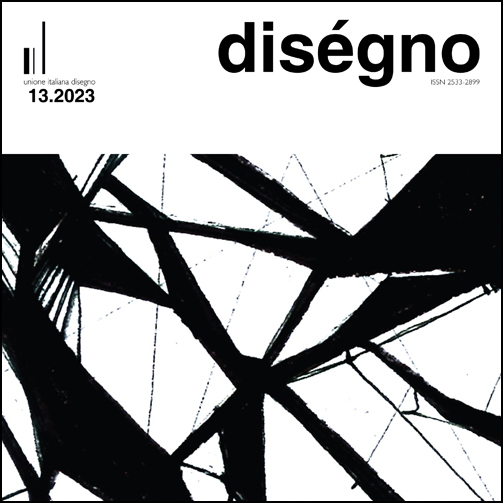Architecture through Drawing
DOI:
https://doi.org/10.26375/disegno.13.2023.6Abstract
The act of drawing has long been the foundational stone for architectural expression. Through the chaotic lines on a canvas, we can understand exaptation as a unique path to diversify architectural drawing frameworks, moving towards environmentally-conscious perspectives. [read more]
Riferimenti bibliografici
Boden, M. A. (2003). The Creative Mind: Myths and Mechanisms. New York: Routledge.
Canetti, E. (2018). La provincia dell’uomo: Quaderni di appunti 1942- 1972. Milano: Adelphi Edizioni.
Chauvet, J.-M., Brunel Deschamps, E., & Hillaire, C. (1996). Dawn of art: the Chauvet Cave: the oldest known paintings in the world. New York: Harry N. Abrams.
Clottes, J., Lewis-Williams, D. (2017). Cave Art. London: Thames & Hudson.
Conkey, M., & Gero, J. (1997). Programme to Practice: Gender and Feminism in Archaeology. In Annual Review of Anthropology, 26, pp. 411-437.
Gould, S.J., Vrba, E.S. (1982). Exaptation – a missing term in the science of form. In Paleobiology, 8.1, pp. 4-15.
Lewis-Williams, D. (2002). The Mind in the Cave: Consciousness and the Origins of Art. London: Thames & Hudson.
Melis, A. (2021). Manierismo e decolonizzazione dell’ordine in architettura. In L. Malfona, A. Crudeli (a cura di), Indagine sul manierismo. Pisa: Pisa University Press. pp. 129-136.
Melis, A., Pievani, T. (2022). Exaptation as a design strategy for resilient communities. In Transdisciplinarity. Cham: Springer International Publishing, pp. 307-327.
Melis, A., Pievani, T., Lara-Hernandez, J.A. (2024). Architectural Exaptation. When Function Follows Form. London: Routledge.
Melis, A., Pievani, T., Medas, B. (2021). Architectural Exaptation. Catalogo del Padiglione Italia “Comunità Resilienti” alla Biennale Architettura 2021, Vol.1a. Roma: D Editore.
Mithen, S. (1996). The Prehistory of the Mind: The Cognitive Origins of Art, Religion, and Science. London: Thames & Hudson.
Pringle, H. (2013). The origins of creativity. In Scientific American, 308(3), pp. 36-43.
Sennett, R., Sendra, P. (2020). Designing disorder: Experiments and disruptions in the city. London-New York: Verso Books.
Soffer, O., Adovasio, J. M., & Hyland, D. C. (2000). The “Venus” Figurines: Textiles, Basketry, Gender, and Status in the Upper Paleolithic. In Current Anthropology, 41(4), pp. 511-537.
Vanhaeren, M. et al. (2006). Middle Paleolithic Shell Beads in Israel and Algeria. In Science, 312(5781), pp. 1785-1788.
White, R. (2012). The Women of Chauvet: Comparing Female Figurines from the Paleolithic. In Current Anthropology, 53(2), pp. 118-128.
Wilson, E. O. (2017). The Origins of Creativity. New York: Liveright Publishing Corporation.
##submission.downloads##
Pubblicato
Come citare
Fascicolo
Sezione
Licenza
Copyright (c) 2023 diségno

TQuesto lavoro è fornito con la licenza Creative Commons Attribuzione 4.0 Internazionale.






